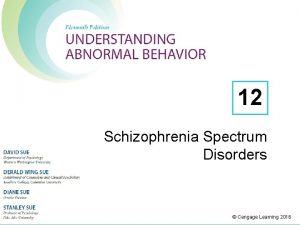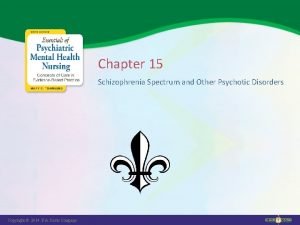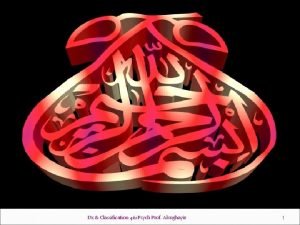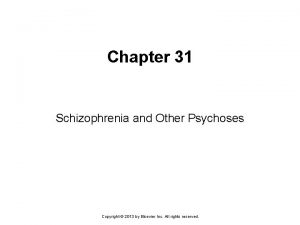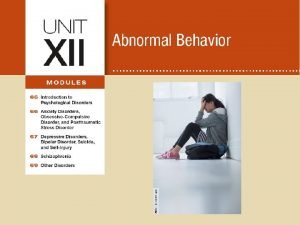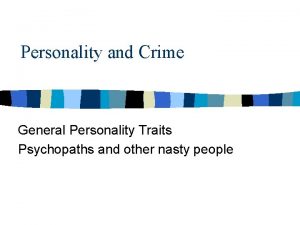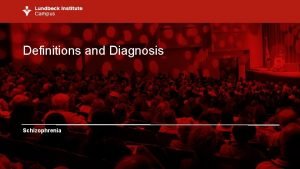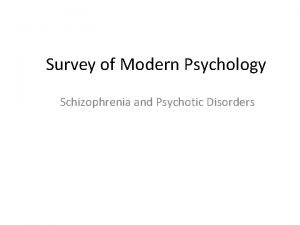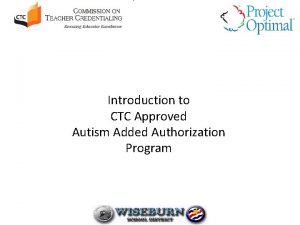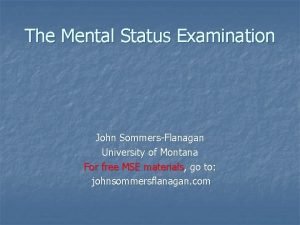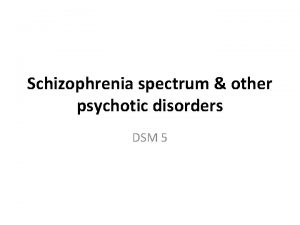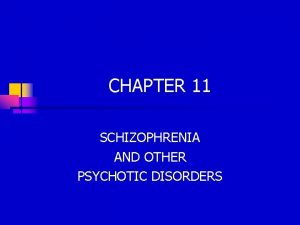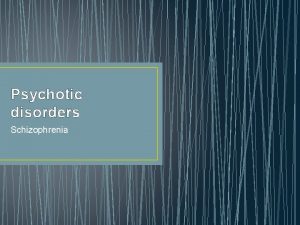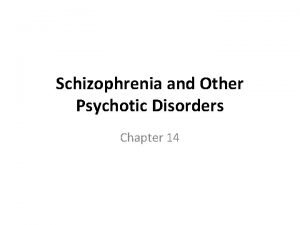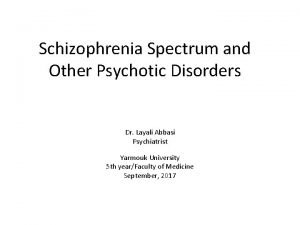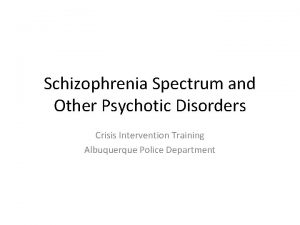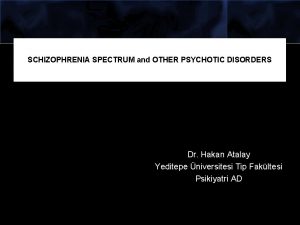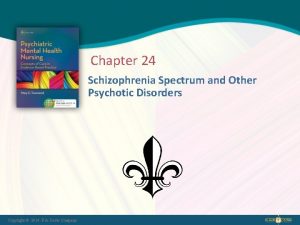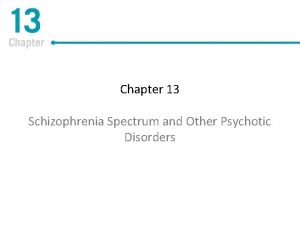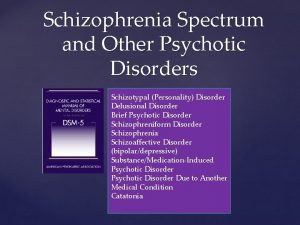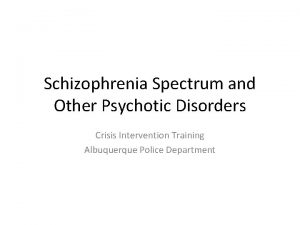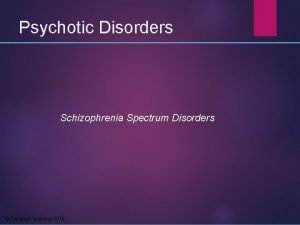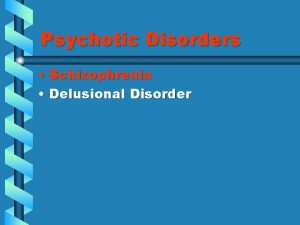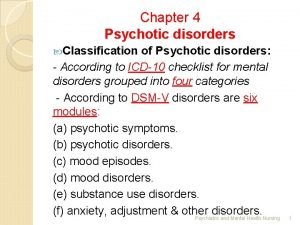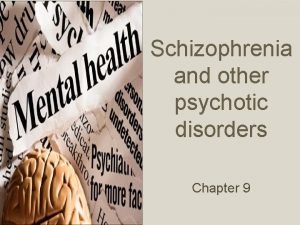Module 12 Schizophrenia Spectrum and Other Psychotic Disorders


















- Slides: 18

Module 12 Schizophrenia Spectrum and Other Psychotic Disorders

The “Positive” Symptom Cluster The Positive Symptoms – Active manifestations of abnormal behavior – Distortions of normal behavior – Disordered thought processes/Disorganized behavior Delusions – Gross misrepresentations of reality – Include delusions of grandeur or persecution Hallucinations – Experience of sensory events without environmental input – Can involve all senses (auditory most common)

“Positive” Symptom Cluster – Disorganized The Disorganized Symptoms – Severe and excess speech, behavior, and emotion Nature of Disorganized Speech – Cognitive slippage – Illogical and incoherent speech – Tangentiality – “Going off on a tangent” – Loose associations – Conversation in unrelated directions • Inappropriate affect - – Odd emotional behavior Disorganized Behavior – Includes a variety of unusual behaviors

The “Negative” Symptom Cluster The Negative Symptoms – Absence or insufficiency of normal behavior Spectrum of Negative Symptoms – Avolition (or apathy) – Lack of initiation and persistence – Alogia – Relative absence of speech – Anhedonia – Lack of pleasure, or indifference – Affective flattening – Little expressed emotion

Other Disorders with Psychotic Features: Schizophreniform Disorder – Schizophrenic symptoms for a few months – Associated with good premorbid functioning – Most resume normal lives – Lifetime prevalence of 0. 2%

Other Disorders with Psychotic Features: Schizoaffective Disorder – Symptoms of schizophrenia and a mood disorder – Both disorders are independent of one another – Prognosis is similar for people with schizophrenia – Such persons do not tend to get better on their own

Other Disorders with Psychotic Features: Delusional Disorder – Delusions that are contrary to reality – Lack other positive and negative symptoms – Types of delusions include: Erotomanic: higher status figure love Grandiose: inflated importance Jealous: unwarranted beliefs of infidelity Persecutory: most common; conspired against Somatic: physical defects, disease, disorder – Extremely rare – Better prognosis than schizophrenia

Additional Disorders with Psychotic Features: Brief Psychotic Disorder – One or more positive symptoms of schizophrenia – Usually precipitated by extreme stress or trauma – Tends to remit on its owns

Schizophrenia: Some Facts and Statistics Onset and Prevalence of Schizophrenia worldwide – Approximately 1% of the population – Often develops in early adulthood – Can emerge at any time – Women have better prognosis Schizophrenia Is Generally Chronic – Life expectancy is slightly less than average

Developmental Research Brain damage – during prenatal or infancy periods may be a cause of schizophrenia Early brain abnormality – may have better prognosis due to brain’s plasticity (ability to compensate) Older adult’s symptoms – demonstrate that the illness may improve over time Levels of impairment – fluctuates between moderate and severe; relapse is common

Causes of Schizophrenia: Findings From Genetic Research Family Studies – Inherit a tendency for schizophrenia, not forms of schizophrenia – Risk increases with genetic relatedness Twin Studies - Monozygotic twins – Risk for schizophrenia is 48% - Fraternal (dizygotic) twins – Risk drops to 17% Adoption Studies -- Risk for schizophrenia remains high

Causes of Schizophrenia: Neurobiological Influences The Dopamine Hypothesis – Drugs that increase dopamine (agonists) Result in schizophrenic-like behavior – Drugs that decrease dopamine (antagonists) Reduce schizophrenic-like behavior Neurological damage? -Structural and Functional Abnormalities in the Brain – Enlarged ventricles and reduced tissue volume

Location of the cerebrospinal fluid in the human brain

Causes of Schizophrenia: Psychological and Social Influences The Role of Stress – May activate underlying vulnerability – May also increase risk of relapse Family Interactions – Families – Show ineffective communication patterns – High expressed emotion – associated with relapse

Medical Treatment of Schizophrenia Historical Treatment Ø primitive brain surgeries in 1500 s Ø prefrontal lobotomies used in 1950’s Ø modern treatment using neuroleptic drugs from 1950’s on www. cerebromente. org. br/n 02/historia/psico 08. jpg

Medical Treatment of Schizophrenia – Compliance with medication is often a problem (medical relationship, cost, poor supports, side effects) – Acute and permanent side effects are common Akinesia: absence, loss, or impairment of the power of voluntary movement Tardive dyskinesia: twitching of the face, trunk, or limbs

Psychosocial Treatment of Schizophrenia – Behavioral (i. e. , token economies) on inpatient units – Community care programs: outpatient; reducing institutionalization – Social and living skills training: teaching appropriate behaviors – Independent living skills: encouraged in community care programs – Behavioral family therapy: helping families to be more supportive – Cognitive-behavioral therapy – Vocational rehabilitation: aiding in job skills and employment

NAME THAT SYMPTOM! Disorder of thought content or delusion Delusion of grandeur Delusion of persecution Auditory hallucination Visual hallucination Olfactory hallucination Tactile hallucination Tangentiality Loose association Waxy flexibility & catatonic immobility Echopraxia Echolalia Alogia Disorganized behavior
 Chapter 12 schizophrenia spectrum disorders
Chapter 12 schizophrenia spectrum disorders Is schizophrenia on a spectrum
Is schizophrenia on a spectrum Anticholinergic rhyme
Anticholinergic rhyme Difference between neurotic and psychotic
Difference between neurotic and psychotic Puberty and autism spectrum disorders
Puberty and autism spectrum disorders Chapter 31 schizophrenia and other psychoses
Chapter 31 schizophrenia and other psychoses Module 68 schizophrenia
Module 68 schizophrenia Psychopath personality traits
Psychopath personality traits Dsm 5 vs dsm 4
Dsm 5 vs dsm 4 Delusional disorder
Delusional disorder Ctc approved autism authorization online
Ctc approved autism authorization online Chapter
Chapter Bipolar and other related disorders
Bipolar and other related disorders Bipolar and other related disorders
Bipolar and other related disorders Absortpion
Absortpion C device module module 1
C device module module 1 Self-initiated other-repair examples
Self-initiated other-repair examples Mood mse
Mood mse Signs of schizophrenia in children
Signs of schizophrenia in children

